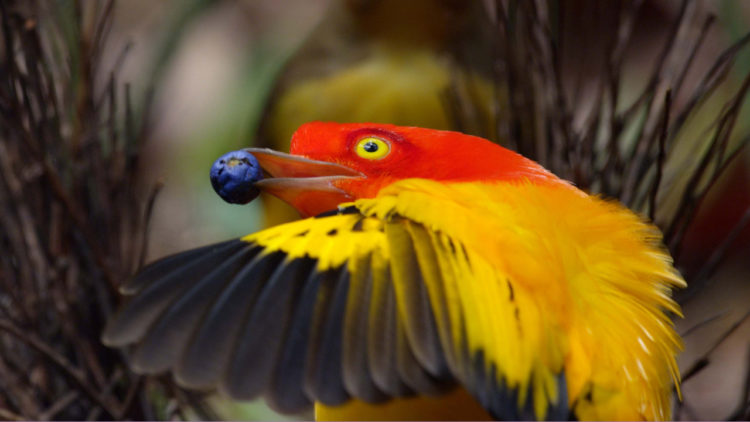The flame bowerbird is a rainforest bird distributed in and endemic to the rainforests of Papua New Guinea. It is one of the most brilliantly colored bowerbirds. The magnificently colored plumage, this bowerbird has been described by naturalists for the first time. The Flame Bowerbirds are named after the elaborate structures, or bowers, built and decorated with colorful objects by the males. Bowerbirds have one of the most exclusive courtship rituals in the animal kingdom.
However, it was earlier thought to be a bird of paradise. Indeed, the male flame bowerbird also has a courtship display along with his bower, and he twists his tails and his wings to the side and then shakes his head rapidly. The Flame Bowerbird is a medium-sized bird, measuring up to 25 cm long, with flame orange and golden yellow plumage with elongated neck plumes and a yellow-tipped black tail. It builds an “avenue-type” bower with two side walls of sticks.
However, the female bird is an olive-brown bird with yellow or golden below. The courtship behavior of the flame bowerbird was filmed by Japanese photographer Tadashi Shimada in Dancers on Fire, a documentary that aired on the Smithsonian Channel.
Although the male appeared to court females twice, no successful mating was filmed as the female moved away when the male mounted. However, Shimada filmed other strange behavior, such as a male courting a juvenile male and numerous juvenile males, as well as an adult male appearing to share one bower, only to be destroyed by another juvenile male.
The bird habitats are lowland and montane rainforest, and adjacent second-growth occurs from lowlands up to 1400m, with Aureus mainly at 850–1400 m. The Flame Bowerbirds’ diet is little known and certainly includes fruits and insects. Forages singly or in small groups, also with other fruit-eating species like Vogelkop Bowerbird.
The display season starts from August to November, when males build and attend a bower to attract females. They build a nest alone and also breed alone. The bower is a so-called avenue bower built with sticks. It’s about 23cm long, 16cm wide, and 19cm high. It’s decorated with purple, blue, and brown fruits, flowers, snail shells, and leaves. The male performs a dance to attract the female to the bower.
There are two different subspecies, sometimes considered full species: Sericulus aureus ardens (flame bowerbird), from south-western New Guinea, has an orange-faced male. Sericulus aureus (masked bowerbird), the nominate form of north-western New Guinea, has a black-faced and black-throated male. The flame bowerbird is assessed as least concerning on the IUCN Red List of Threatened Species.
Also, Read! The Fascinating Silver-eared Mesia













